 |
| Category: Boer War |

|
|
|
|
|
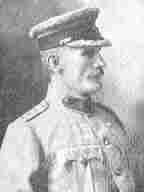 |
- 1st Australian
Regiment
|
|
|
-
Colonel John C Hoad, (Commanding
Officer, 27 Nov. 1899 -- 7 April 1900) |
This was the first
time a Regiment was formed for active service comprising
troops representing the Colonies of Australia.
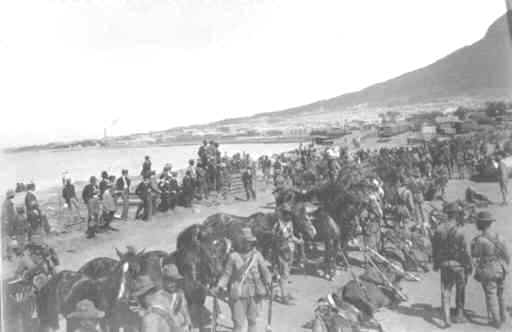
Victorian Mounted Rifles entraining for the
front at Cape Town under Table Mountain. This unit formed the core of the
pre-Federation 1st Australian Regiment which included nearly all the
Australian Colonial forces then in South Africa.
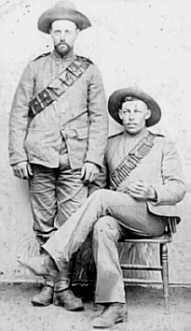 |
- <<
Privates Percy Dargie (seated) and John Edge of 5 Victoria
Mounted Rifles at Vryheid in 1901. Photo provided by Dargie's g/daughter
in-law Brenda Dargie.
- John
Victor O'Farrell. He earned a QSA medal (shown wearing) and KSA,
with clasps for Transvaal, Orange Free State & Cape Colony.
Photo provided by grand niece Lynette
Prislan.>>
|
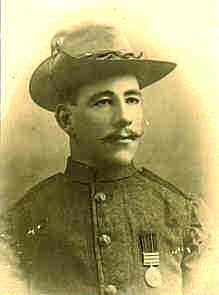
|
- Victorians killed in action
At Jasfontein, 9 February 1900
- William J. Lambie, Senior Military Correspondent
Melbourne Age, attached to the Regiment
-
At Rensburg, 10 February 1900
- No. 2 Sgt. N Grant (see below)
- No. 74 Pte A. H. Willson
- Sergeant Neil Grant died from bullet wounds in
the chest. Trooper A.H. Willson, quick to go
to his aid, was killed instantly as he bent over the wounded man. Grant
was shot by a young boy using a sporting rifle, the weight
of the Mauser being too much for him. The second shot came from
the boy's father who shot Willson in the head. Within full view of
the parent a Dragoon then shot the son dead.
- The immediate
reaction of grief and dismay of the father caused him to bound
from cover to his feet completely oblivious to his danger. In a
matter of seconds he fell riddled with bullets from every Lee
Metford levelled at him.
- SOURCE: Wallace R.L.: The Australians at the Boer
War: AWM & AGPS: Canberra: 1976: p.111.
|
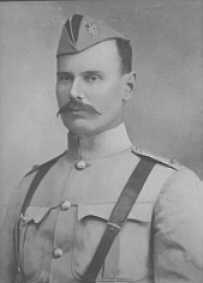 |
- At Rensburg, 12 February 1900
- Major G. A. Eddy (see below)
- No 4 Cpl. A. Ross
- No. 55 Pte C. E. Williams
- No. 89 Pte T. Stock
|
Major Eddy,
while retiring with his men at
Rensburg, brought them forward again to cover the retreat
of the 2nd Bn. Wiltshire Regiment and was killed. He was
born at Castlemaine, Victoria, in 1860. Photo kindly
provided by Rob Drooglever.
- BATTLE OF RENSBURG (Hobkirk's Farm
"Pink Hill"), 12 February 1900
- Account by a Boer prisoner
to a correspondent of the Daily Mail of the trap into which the
2nd/Worcesters had fallen and the attempted rescue of them by the
Australians under Major Eddy, at Hobkirk's Farm, near Colesburg, 12th
February 1900.
-
- I saw a long row of their dead and
wounded laid out on the slope of a farmhouse that evening - they were
all young men, fine big fellows. I could have cried to look at them so
cold and still. They had been so brave in the morning, so strong, but in
the evening a few hours later they were dead, and we had not hated them
nor they us.
- It was a cruel fight. We had ambushed a
lot of the British troops - the Worcesters, I think they called them.
They could neither advance nor retire; we had them penned in like sheep,
and our field cornet, van Leyden, was beseeching them to throw down
their rifles to save being slaughtered, for they had no chance. Just
then we saw about a hundred Australians come bounding over the rock in
the gully behind us. There were two great big men in front cheering them
on.
- We turned and gave them a volley, but
it did not stop them. They rushed over everything, firing as they came,
not wildly, but with the quick sharp upward jerk to the shoulder, the
rapid sight then the shot. They knocked over a lot of our men, but we
had a splendid position. They had to expose themselves in order to get
to us, and we shot them as they came at us. They were rushing to the
rescue of the English. It was splendid but it was madness.
- On they came and we lay behind the
boulders, and our rifles snapped and snapped again at pistol range but
we did not stop those wild men until they charged right into a little
basin which was fringed around all its edges by rocks covered with
bushes. Our men lay there as thick as locusts, and the Australians were
fairly trapped. They were far worse off than the Worcesters up high in
the ravine.
- Our field cornet gave the order to
cease firing and called on them to throw down their rifles or die. Then
one of the big officers -- a great rough-looking man, with a voice like
a bull, roared out "forward Australia! no surrender!" These
were the last words he ever uttered for a man on my right put a bullet
clean between his eyes and he fell forward dead. We found later that his
name was Major Eddy, of the Victorian Rifles.
He was as brave as a lion but a Mauser bullet will stop the bravest. His
men dashed at the rocks like wolves; it was awful to see them. They
smashed at our heads with clubbed rifles or thrust their rifles up
against us through the rocks and fired. One after another their leaders
fell. The second big man went down early, but he was not killed. He was
shot through the groin, but not dangerously. His name was Captain
McInerney.
-
- There was another one, a little man
named Lieutenant Roberts; he was shot through the heart. Some of the
others I forget. The men would not throw down their rifles; they fought
like furies. One man I saw climbed right on to the rocky ledge where big
Jan Aldrecht was stationed. Just as he got there a bullet took him and
he staggered and dropped his rifle. Big Jan jumped froward to catch him
before he toppled over the ledge, but the Australian struck Jan in the
mouth with his clenched fist and [he] fell over into the ravine below
and was killed.
- We killed and wounded an awful lot of
them, but some got away; they fought their way out. I saw a long row of
their dead and wounded laid out on the slope of a farmhouse that evening
- they were all young men, fine big fellows. I could have cried to look
at them so cold and still. They had been so brave in the morning, so
strong, but in the evening a few hours later they were dead, and we had
not hated them nor they us.
SOURCE: THE MELBOURNE ARGUS, WEDNESDAY MAY
23rd 1900.
|
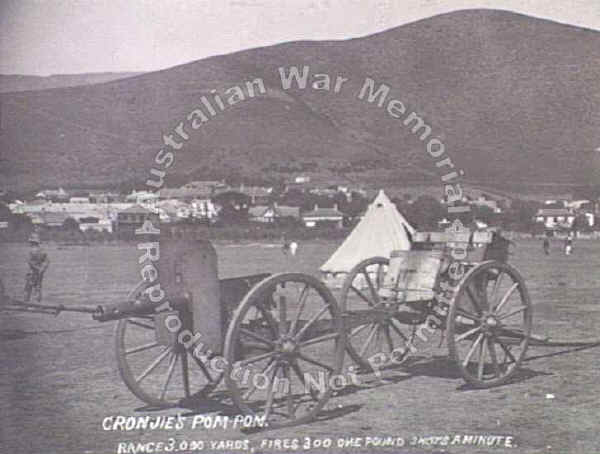 |
| Cape
Town, South Africa, C.1900. Maxim one pound automatic gun, called a
"Pom Pom" captured from General Cronje at Paardeberg in
1900. (Donor T Collins) |
- Colonel Sir George Bell was born in
Sale Victoria on 29 November 1872. He
joined the Victorian Mounted Rifles in 1892. Was a member of the
contingent representing that colony at Queen Victoria's Diamond
Jubilee visiting England in 1897. Went to the Boer War in 1899 as a
member of the 1st Australian
Regiment and served later in
5VMR
until 1902. He rose to the rank of Captain, February 1901.
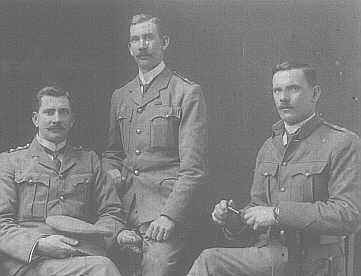 |
George
was severely wounded at Bakkop on 4 January 1902. He was mentioned
in despatches London Gazette 29/07/02 and awarded DSO London
gazette 31/10/02. He also received the Queen's medal (QSA) with
six clasps and the King's medal with two clasps.
(L to R) Captain TSL
O'Reilly DSO, Lt Leslie Maygar VC, George Bell DSO. Photo by Duffus
Bros. Cape Town and Johannesburg, c. 1901
|
- He went to live in Tasmania in
1904. Joined the 3rd Light
Horse Regiment at the outbreak
of WW1 1914. Served in Gallipoli, and commanded the 3rd regiment in
Sinai and Palestine as Lieut. Col. Also acting Brigadier of 1st.
Light Horse Brigade during
1917.
-
- Again mentioned in despatches and
awarded CMG 1917. He returned to Tasmania July 1919.Stood for
Federal election November that year for seat of Darwin N.W. Tasmania.
Held that seat with one break (1922-1925) until 1943. He was Speaker
of the House of Representatives from 1934-1940 and was given the honorary
rank of Colonel in 1933. Colonel Bell was knighted in 1941.
-
- His first opponent when he stood
for parliament in 1919 was Joe Lyons then standing for the Labor
Party. Bell won the election, the only person to ever beat Lyons at
an election. After Lyons's defection from Labor and the success of
the United Aust. Party at the elections of 1932 George Bell was
elected Chairman of Committees.
-
- George Bell resigned his seat prior
to the federal election in 1943. At the election Dame Enid Lyons
stood for the seat of Darwin and became the first woman member of
the House of Representatives. He died on the 5th of March 1944 and
was given a state funeral.
Information and photo kindly provided by
his proud grandson George Bell
Much of this information
came from Defending
Victoria |
|








